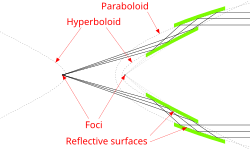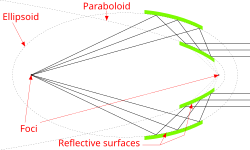Wolter telescope

An X-ray telescope that uses a mirror arrangement as proposed by the German physicist Hans Wolter in 1952 is called a Wolter telescope . This makes use of the fact that the refractive index of materials for X-ray radiation is somewhat smaller than one, and therefore total reflection occurs when the surfaces are grazed by incidence .
This mirror arrangement is composed of metallic paraboloids of revolution (often consisting only of coated foils ) nested inside one another , each of which is followed by a hyperboloid of revolution. Ellipsoids of revolution are also used in combination with paraboloids of revolution. Together, these mirrors have similar imaging properties to conventional telescopes in the visible range of light .
The principle was proposed back in 1952. Due to the required extreme accuracy of the surfaces, the roughness of which may only be a few millionths of a millimeter, it took until 1978 before the first Wolter telescope could be implemented in the Einstein X-ray satellite .
Types of Wolter Telescopes
Wolter types I and II consist of a combination of a paraboloid and a hyperboloid mirror system. In a Wolter-I system, the reflection always takes place on the inside of the mirror system, whereas in a Wolter-II system the first reflection takes place on the inside of the paraboloid mirror and the second reflection on the outside of the hyperboloid mirror.
Wolter Type III systems first reflect the X-ray photons on the outside of a paraboloid, which are then focused on the inside of an ellipsoid mirror.
Applications
The X-ray satellite XMM-Newton uses three Wolter-I systems, each with 57 nested mirrors.
The eROSITA X-ray telescope , which was launched on July 13, 2019, uses seven Wolter-I systems, each with 54 nested mirrors.
See also
literature
- H. Wolter: Mirror systems of grazing incidence as imaging optics for X-rays. In: Annals of Physics. 10: 94-114 (1952).
Web links
- Arndt Last: Wolter optics. Retrieved November 21, 2019 .


